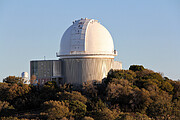NOAO: A Sharp-Eyed Future for Historic Kitt Peak Telescope
12 October 2015
A team led by the California Institute of Technology has been selected to transform the venerable 2.1 meter telescope at Kitt Peak National Observatory into the first dedicated adaptive optics (AO) observatory for astronomy. This system, named Robo-AO KP, will allow astronomers to study, at high angular resolution, large numbers of astronomical objects, spanning science from planetary to stellar, and exoplanetary to extragalactic.
Robo-AO has been used for science observations on the Palomar Observatory 1.5 meter telescope since 2011, and has thus far been the only robotic laser adaptive optics system in existence. It will be transferred later this year to the Kitt Peak 2.1 meter telescope to support long-term observing projects, where it will be able to take advantage of the larger aperture, as well as Kitt Peak’s more favorable observing conditions. The team behind Robo-AO KP includes Prof. Shrinivas Kulkarni (Caltech), Dr. Reed Riddle (Caltech), Prof. Christoph Baranec (University of Hawai’i at Manoa), Prof. Nicholas Law (University of North Carolina at Chapel Hill), and Dr. Dmitry Duev (Caltech).
As the second major telescope to be constructed on Kitt Peak, the 2.1m has been in continual operation since 1964. The history of the telescope includes many important discoveries in astrophysics such as the Lyman alpha forest in quasars, the first gravitational lens by a galaxy, the first pulsating white dwarf, and the first comprehensive study of the binary frequency of stars like the sun. Over the years, many astronomers have used different instruments with this telescope.
With Robo-AO KP, astronomers will be able to explore large classes of objects at high angular resolution at visible wavelengths, including the environments of candidate exoplanet host stars, binary asteroids, weather on planets in our own solar system, multiple stars in young stellar clusters, and distant lensed quasars. Robo-AO has already studied thousands of candidate exoplanets from the Kepler mission that require follow-up observations at higher resolution to confirm that a companion secondary star is not confusing the observation. Among the team’s discoveries: a quadruple star system with a planet, confirmation of the first discovered Kepler K2 planet, and hundreds of new binary stars. The team anticipates that Robo-AO KP will also provide direct images of the most massive exoplanets and brown dwarfs orbiting other stars.
Just as a penny seen at the bottom of a swimming pool looks blurred and seems to wiggle, stars seen through the Earth’s atmosphere appear to twinkle and appear larger than they are. While this twinkling is enthralling to children, it degrades the performance of ground-based telescopes as it causes a serious loss of spatial detail in any celestial object under study. In recent decades, the U.S. military, and later astronomers, have developed technology referred to as adaptive optics to overcome the blurring effect from the Earth’s atmosphere. Robo-AO uses an ultraviolet laser to create an artificial guide star on the sky to measure this blurring. Observing this artificial star, created at a distance of 10km (6.2 miles) from the telescope, makes it possible to correct celestial images by reflecting the light off a deformable mirror so that the much fainter target object can be observed at higher angular resolution. It achieves images close to the theoretical limit possible for a similar telescope outside the Earth’s atmosphere – making a ground based telescope like the 2.1m perform closer in capability to the Hubble telescope!
As its name implies, Robo-AO operates autonomously (although the telescope will still use an operator to handle routine opening and closing of the dome and monitoring of the weather), making it the most efficient adaptive optics system in use today. The ultraviolet laser guide star beam will not be visible to the human eye, it will not distract or affect airplane pilots, or produce radiation that is hazardous during momentary exposures. During the day the public will continue to be able to view the 2.1m telescope, and the attached Robo-AO KP instrument from the visitor gallery.
Robo-AO produces an enormous amount of data. To handle the data stream, the team has developed an automated data-processing pipeline: at the 2.1m the data will undergo initial processing and storage both at the telescope and at Caltech to make it available to scientists for analysis. Two months of observing time each year will be available to the broad United States astronomical community, who thus far have had only limited access to Robo-AO.
More information
Kitt Peak National Observatory is a division of the National Optical Astronomy Observatory, which is operated by the Association of Universities for Research in Astronomy Inc. under a cooperative agreement with the National Science Foundation.
Contacts
Dr. Reed L. Riddle
Project Scientist, Robo-AO KP California Institute of Technology
1200 E. California Blvd. MC 11-17 Pasadena, CA 91125-1700
Tel: 626-395-8944




